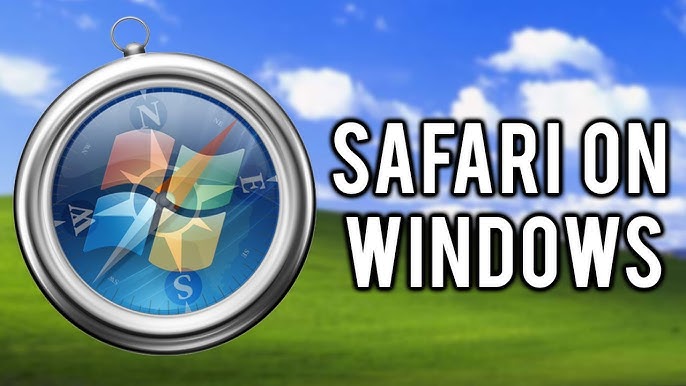Safari for Windows is one such relic that some people still recall with fondness. It was Apple’s brief effort to bring its clean, WebKit-based browser to PCs. That short venture ended many years ago, yet there remains interest among developers and enthusiasts who wonder if there is any value left in reviving, and perhaps even using Safari on Windows today.
Is that longing just a sentimental tap on the shoulder, or does any real substance lie beneath? Let us explore the history, charm, the challenges, and ultimately assess whether the nostalgia is worth the limitations.
A Short History of Safari on Windows
Safari first came to Windows back in 2007. Apple announced Safari 3 for Windows at its Worldwide Developers Conference that year. That paved the way to let people on Windows try out a different kind of browser. For a time, it was part of Apple’s strategy to reach users beyond its own platforms. By the time Safari 5 arrived, Apple allowed Windows users to install it, though the company was already shifting focus back to its own operating systems.
The version that would stand as the last one for Windows was Safari 5.1.7. That appeared in 2010. After that, Apple stopped offering updates or support for Windows entirely. From then on, any Windows installation of Safari remained frozen in time. No new features, no security patches, no compatibility improvements. So that means anyone who still has Safari on Windows is running something that is over a decade old.
Why Some Users Remember It Fondly
Why do memories of Safari on Windows still linger for some people? Anecdotes collected from former users point to several aspects. First there was the striking speed. Compared to Internet Explorer or early versions of Firefox, Safari felt noticeably faster. Some users have said it was lightweight, responsive, and handled HTML5 elements with flair before most other browsers caught up.
It also looked different. The user interface was clean and minimal. Chrome had not yet captured the minimal design trend. Safari stood out with a simple toolbar, optional scroll bars, and an uncluttered feel. It was sleek. For many, it felt like a fresh approach to browsing.
Here is a recollection that appeared on a discussion thread years ago: “Safari on Windows Vista was blazing fast and spearheaded HTML5 especially compared to Firefox and Opera.” Others commented that after years with clunky Internet Explorer versions, Safari felt like a breath of fresh air, especially when it started showing modern capabilities ahead of the rest of the pack.
The Reality of an Outdated Browser
But nostalgia aside, the reality is that Safari for Windows is outdated in critical ways. First and perhaps most importantly, it is not supported. Without updates, using it exposes you to security vulnerabilities. In an age when safe browsing, phishing protection, and secure rendering are essential, relying on an unsupported browser is a serious risk. No developer, no IT team, and no daily user can disregard the threat posed by unpatched software.
Compatibility is another major issue. Safari for Windows was designed for Windows XP and Vista, maybe early Windows 7. Trying to run it on modern Windows 10 or Windows 11 often leads to glitches, crashes, or the browser simply refusing to install. While some people have tried compatibility modes or virtual machines, the experience is neither stable nor reliable.
Feature wise, the browser lacks modern essentials. Anything Apple added after 2010 is completely absent. That includes general improvements like hardware acceleration for video and animations, modern privacy protections, intelligent tracking prevention, support for new web standards, improved extension frameworks, and much more. Simply put, it cannot render many modern websites correctly or securely.
When Nostalgia Might Have Value
So if it is not suitable for everyday browsing, why might someone still find value in it? There are a few narrow scenarios.
Developers who need to test how sites behaved in that specific version may find it useful. Especially when supporting legacy systems or diagnosing rendering bugs that only occurred on Safari 5.1.7. For that, having a reference environment, even if outdated, can be meaningful.
Those doing historical or archival research into browser evolution might benefit from running the actual software. It offers a tangible link to the browsing landscape of the late 2000s. That sense of operating the original version can offer insight that purely theoretical study cannot.
When It Simply Does Not Add Up
But for regular browsing, work, or modern testing, the drawbacks totally outweigh any nostalgia. Security risks, lack of modern feature support, poor compatibility, no developer tools that match today’s standards, all of that make it impractical. There are safe and effective alternatives for anyone wanting to explore or test old versions of browsers.
Safer Alternatives for Nostalgia or Testing
One of the best modern approaches is to use virtualization or remote browser testing platforms. Cloud tools, for example, give you the ability to simulate old browser and operating system combinations without installing them yourself. That is safer, easier, and far more reliable. Through those platforms you can still see exactly what Safari on Windows looked like, how it behaved, without compromising your computer or data.
Another option is to rely on modern versions of Safari running on macOS. That gives you a current, secure, and coherent browsing experience, even if it differs from how Safari worked on Windows back in 2010.
If your goal is insight into the core rendering engine, WebKit, then you might explore developer releases or open source builds of WebKit on Windows. Though aimed at developers, they can give a functional look into how WebKit processes websites without relying on the old Safari UI.
Is the nostalgia worth the limitations? For a short burst of memory, sure. Perhaps you want to vault back fifteen years and feel what it was like to surf with something new and minimalist. But if you intend to actually use it for anything, development, browsing, testing, its limitations are too significant.
That last Safari for Windows version is now a historical artifact. It preserves a moment in browser evolution. It shows how Apple once attempted to gain ground on Windows with something fast and modern at the time. But it has long since stopped evolving. It remains stuck in an earlier era that is poorly compatible with today.
For modern uses, strong alternatives exist. Virtual machines and browser Windows emulators provide safe access. Modern Safari versions offer enhanced privacy, performance, and standards support. Developer builds of WebKit offer insight into rendering behavior.
A Thought for the Nostalgic
If you are driven by nostalgia, choose a secure and contained environment to revisit the past. Run it in a virtual machine that is isolated. Do not expose it to the internet or use it for any browsing beyond controlled local scenarios. Let it remind you of how far browsers have come, but do not confuse that experience with viability in 2025.
Test on Real Safari Browser for Windows
Safari isn’t officially available for Windows anymore, but developers and testers still need to check how websites work on real Safari browsers. This matters when you’re making sure your site works across different browsers, or when you have users on macOS who still need support.
Running Safari natively on Windows is a bad idea. It’s outdated and insecure since Apple stopped releasing updates and patches. The old version doesn’t support modern web standards either. Cloud-based testing platforms solve this problem.
Cloud testing platforms like LambdaTest solve the Safari-for-Windows challenge by providing access to real Safari browsers hosted in the cloud. Developers can instantly test their websites on Safari without needing a Mac, making cross-browser compatibility checks much easier. This ensures that teams avoid costly blind spots where Safari users face bugs that other browsers don’t.
By using LambdaTest, you can replicate real-world Safari behavior, identify rendering differences, and validate performance without investing in additional hardware. This not only saves time but also ensures broader audience coverage by including one of the most widely used browsers in your testing process.
Why LambdaTest works well for Safari testing on Windows:
- No downloads needed: Skip the sketchy Safari .exe files floating around online
- Real macOS access: Test Safari running on actual Mac systems from your Windows computer
- Live debugging: Use developer tools and console logs to inspect and fix issues in real time
- Automated testing: Run Selenium scripts across Safari versions through your CI/CD pipeline
Whether you need to support older Safari versions or test the newest macOS browser, LambdaTest fills the gap left when Apple killed Safari for Windows. Your site will work consistently across browsers without security risks or accuracy problems.
Conclusion
Safari for Windows was fast, sleek, and felt modern back in the late 2000s. It made an impression on some Windows users who noticed the difference. Yet Apple abandoned it and it froze at version 5.1.7 in 2010. No security updates. No feature improvements. No modern compatibility. The user interface and rendering engine remained locked in another era.
Although Safari for Windows is no longer officially supported, developers and testers still need a reliable way to verify Safari compatibility. With AI-driven test automation, it becomes easier to simulate user journeys, predict potential UI issues, and reduce redundant checks. AI brings efficiency by learning patterns from test runs, helping teams maintain coverage even when direct access to Safari for Windows is limited.










